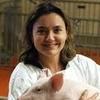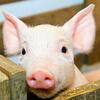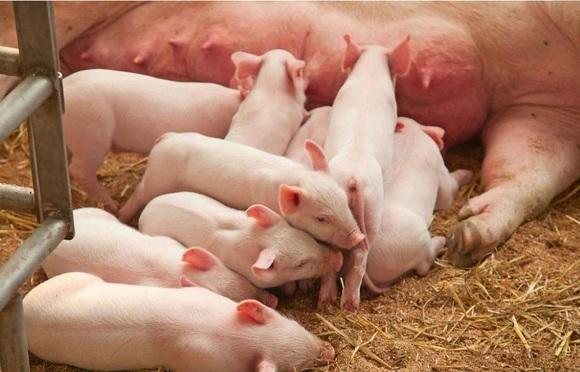Explore all the information on
Swine welfare
Some farming methods have ignored the pigs’ needs by treating them as production units rather than fascinating and intelligent creatures with innate behavioural and physical needs.
Pigs are sensitive to extremes of climate and have no sweat glands (except for on the tip of the snout) nor thick hair cover, relying on fat for insulation. In cold weather pigs often huddle to keep warm, whilst in warm weather they wallow in water and mud to keep cool. Pigs forage and root for food (a strong natural behaviour), and eat a wide range of vegetables and animal products, including carrion. In terms of senses, pigs rely on smell and hearing more than vision. They have a wide range of vocalisations and a good ability to locate odour sources.
Pigs prefer to live in stable families or small groups. However, they can be aggressive to each other, especially if unfamiliar animals are mixed. Boars are often solitary. Contrary to popular belief, pigs are clean animals and if given properly designed living accommodation, will always tend to use one particular area for dunging, thereby keeping their lying/sleeping area clean.
INTRODUCTION
Gas, odor, and particulate concentrations and emissions have been, and will continue to be, targeted components of livestock and poultry production systems. Local units of government (counties and townships) have or are considering the establishment of setback requirements from rural residences and livestock operations to prevent odor and other nuisance complaints. State and...
Comments : 1
Recommendations: 0
As a result of COVID-19, veterinarians need to look at biosecurity in new ways. As practitioners we have to focus on protecting pigs and maintaining the economic viability of the farm. We are trained to deal with zoonotic diseases with a primary goal of protecting ourselves, our clients, and the food supply chain. Yet, now we are being asked to think more broadly, more holistically as an occupational (One Health) specialist, thinking about the health of farm employees, their families, and...
Comments : 0
Recommendations: 1
Introduction Retention of dietary protein to body protein is an inefficient process in pigs. Nitrogen balance studies have shown that nitrogen retention rate (proportion of intake) ranges from 41 - 68% in weaner pigs (Cera et al., 1988), 42 - 56% in grower pigs (Fabian et al., 2004, Otto et al., 2003, Zervas and Zijlstra, 2002), 30 - 46% in finisher pigs (Fabian et al., 2004), and 42 - 52% in sows (Renteria-Flores et al., 2008). These findings, based on the mean values from...
Comments : 0
Recommendations: 1
Silvafeed® plant extracts: a performing natural alternative to antibiotics in maximising gut health Implementing new practices that aim at improving animal welfare is no easy task. There are diverse signals from famers and veterinarians that, under the condition of current animal farming, livestock welfare appears endangered, as individual animals and entire flocks or herds show clinical signs of discomfort and...
Comments : 2
Recommendations: 1
INTRODUCTION Modern livestock production is characterized by intensification, i.e., a higher number of animals per farm. To achieve successful intensification of livestock production, without negative effects on animals, farmers and farms, certain requirements need to be met. One of these requirements for intensification of livestock production is the capability of the farmer to take care of a larger number of animals. This requires healthy and easy-to-manage animals that need...
Comments : 0
Recommendations: 0
Scott Dee (Pipestone) showed research on the responsible use of antibiotics, analyzing pig production performance and welfare after a PRRS virus challenge, during 2019 NIAA Annual Conference: Animal Agriculture - Innovation, Technology and Consumer Engagement in Des Moines, Iowa, USA....
Comments : 0
Recommendations: 1
Cia Johnson (AVMA) discussed guidance and standards for euthanasia, slaughter and depopulation of animals, during 2019 NIAA Annual Conference: Animal Agriculture - Innovation, Technology and Consumer Engagement in Des Moines, Iowa, USA....
Comments : 0
Recommendations: 0
Cysticercosis due to Taenia solium is a parasitic disease typically associated with underdevelopment in communities with limited economic resources. In these communities, pigs are raised in primitive conditions. Moreover, people defecate outdoors, live in overcrowded households, and lack sanitary education and adequate environmental health conditions.1,2 Commonly, humans get infected with the intestinal tapeworm by ingesting it in the larval stage (cysticercus) in the meat of...
Comments : 0
Recommendations: 0
1. As energy source of intestinal cell 2. Improve intestinal morphology and promote digestion and absorption ability of intestine 3. Maintain the normal morphology of mucosal epithelial cells 5. maintain GIT's bacteria flora And what more do you know about it? ...
Comments : 1
Recommendations: 0
Researchers at the University of Missouri have successfully produced a litter of pigs that are genetically resistant to a deadly porcine virus.
Coronaviruses, highly contagious and widespread viruses known for their distinctive microscopic halos, are responsible for a variety of deadly intestinal diseases in livestock. One such virus, Transmissible Gastroenteritis Virus (TGEV), commonly infects the intestines of pigs, causing ...
Comments : 0
Recommendations: 1


Isoleucine Plays a Critical Role in Low-Protein Diets
Suggested link
Introduction Hospital pens, or infirmary pens, are often used to facilitate the treatment of sick animals and separate them from those that are healthy (Fraser et al., 2013). In these pens, pigs are able to recover without competing with healthy animals for water, food, or rest areas (Pineiro et al., 2014). In Denmark, there is a law that specifies how a hospital pen should be designed, which addresses requirements, such as bedding material, cooling,...
Comments : 0
Recommendations: 1
INTRODUCTION Brazil is the fourth largest producer and exporter of pork worldwide, rearing pigs under intensive feedlot conditions, to optimize production and economic performances (BAPTISTA et al., 2011). Constant and growing consumer concerns about animal welfare and rearing conditions have boosted the search for sustainable social-friendly production systems (SARUBBI et al., 2010). In conventional swine rearing systems, animals are housed in separate facilities,...
Comments : 1
Recommendations: 1
Introduction More than 60% of pigs are reared outdoors in Uruguay, with variable participation of pastures in feed (DIEA, 2007). Outdoor production systems with pastures are becoming attractive for consumers, mainly due to environmental sustainability and social benefits of the sector as well as the initial low cost of the production system (Leite et al., 2001). In addition, outdoor rotation systems have been reported to be of interest in South America because they have been...
Comments : 0
Recommendations: 0
Introduction Both humans and livestock are susceptible to high thermal loads that can cause acute, chronic, and lethal illness due to heat stress-related pathologies. In 2003, approximately 50,000 Europeans died during an intense heat-wave [1,2]. More recently, about 11,000 people succumbed to heat stress in Moscow during an abnormally hot 2010 summer [3]. Besides cooling and rehydration, there are few standard medical procedures to treat heat stroke and mortality for patients...
Comments : 0
Recommendations: 1
Introduction Swine raising has changed considerably in the last 30 years with an increase in intensive production systems. Whereas intensive systems minimize production costs, the high animal densities can pose impacts to environments that have low soil absorption capacity (Kunz et al., 2009a; Vanotti et al., 2009). Thus, confined animal feeding operations (CAFOs) while reducing the production costs can increase the use of water and the environmental impacts associated with the...
Comments : 0
Recommendations: 0
Introduction Heat stress (HS) is a major environmental hazard for both humans and animals. Despite advances in the understanding of heat-related illnesses, there is no treatment against specific aspects of their pathophysiology, and protocols are limited to generic cooling and rehydration (Leon and Helwig 1985). Therefore, a better understanding of the biological consequences of HS is critical in order to develop effective treatment protocols and mitigation...
Comments : 0
Recommendations: 1
Does It Make a Difference If a New Pig Barn is Built In an Area With Existing Barns?
A model, called the Community Assessment Model for Odor Dispersion (CAM), was developed to predict receptor odor exposure from multiple swine production sources. The intended use of CAM was to provide a tool for evaluating the odor exposure to receptors in a community when siting new swine production systems and how a change in odor control technology alters the odor exposure to...
Comments : 1
Recommendations: 0
1. Introduction Transport is an essential and critical factor in modern pork production. During transport, pigs experience many undesirable factors and potential weather extremes. Factors that impact the pig’s well-being during transportation include: space allowance and loading density [1,2], transport duration [3], trailer design [4–6], handling methods [7] and trailer management [1,5,8,9]. Specifically, great challenges for maintaining...
Comments : 0
Recommendations: 0
Introduction High ambient temperature-elicited heat stress (HS) is a detrimental pathophysiological event. Besides its threat to human health (Changnon et al. 1996; Leon and Helwig 2010), HS also negatively affects the growth performance, reproduction, and health status of farm animals (Hansen 2009; Renaudeau et al. 2011). Annual cost of HS on the US swine industry is over $300 million (St-Pierre et al. 2003). Under high ambient temperature, inadequate release of body heat...
Comments : 0
Recommendations: 1
Introduction Heat stress (HS) is a major environmental hazard for both humans and animals. Heat claims more human lives than all other climatic events combined (Changnon et al. 1996), with the young and elderly populations being the most susceptible (Leon and Helwig 2010). Surprisingly, despite increased understanding on the pathophysiology of heat-related illnesses (Bouchama and Knochel 2002), the only standard procedures to treat heat victims are cooling and rehydration (Leon...
Comments : 0
Recommendations: 1


.mp4&w=3840&q=75)






.jpg&w=3840&q=75)















